Note
This is random but I think it came to mind because of your use of water colour paints.
I was just wondering if you've ever heard of or seen Arthur Spiderwick's Field Guide to the Fantastical World Around You


Personally, it was a formative experience for me in developing my interest and taste in art and eventually spec bio.
If you've never seen it before I recommend it as an interesting and immersive read.

This butterfly handler especially reminded me of the birg child, showing off it's pets you did a portrait for.

So yeah, this was really random.
I was FASCINATED by this book as a kid. I didn’t own a copy but i remember flipping through it with wonder at my cousin’s house. Absolutely a formative work for me.
195 notes
·
View notes
Text
Thinking about how some of my favorite little guys would talk. Meme template is from this post


#having a bit of fun#im scared of talking about my ocs in public but perhaps yall will get a kick out of this as I did#ocs#swooce#ahabblefrupp
251 notes
·
View notes
Note
Hello!!
I really adore all the birg worldbuilding!!!
I was planning on making my own birg OCs and story, but i needed to ask, i saw these birg predators that look like bigger birgs but with mantis arms; Do they have cultures? How do they get along with birgs? I NEED TA KNOOWW
Tbh I’ve waffled on how I want to approach them for a while, in their current iteration they are very intelligent animals, as a chimp or gorilla with the habits of a lion might be to us. They may have rudimentary cultures unique to their small social units like orcas, but they lack a fully fledged language. They are frequently solitary or in bonded pairs, working collaboratively to raise cubs for up to 5 years before the offspring set out on their own. As a pair, they are formidable predators, one working to flush prey into the ambush of the other, with occasional support from their young. Large midarms are used to restrain prey while the hooked beak finds a vital artery or the brain of the animal. The beak-like chelicerae are also capable of protruding from the face to give a little extra reach to their bite.
They produce low hums and grumbles to communicate, many of which are below the register of a birg’s ears, but resonate through their bodies in an unsettling manner. Their elbow pinnae are much more prominent than those of birgs. Rather than hibernate, most extant populations cross the ice belt each fall to follow the sun to the other hemisphere. Others do as the ombs and continue to hunt through the long night.
As for their relationship with birgs, they are frequently embellished in art and folklore as werewolf or ogre-like monsters. A widespread story explaining the Twowi taboo against consuming the flesh of trunkhorses warns that those who wantonly spill blood as the HaJhaub do will be cursed to transform into one. The kakroum warn their children to never stray from their nanny or speak curses of their aunties, lest the Oh’jub should hear them and steal them away in the night. In some tales, the child is simply eaten, but other legends insist that the Oh’jub produces no offspring of her own, but instead transforms young birgs into more Oh’jub by feeding them her own blood, as a birg would nourish their infant larvae.

So yeah hope this helps
—————
For more misc worldbuilding, see my patreon
Kofi
Inprnt
319 notes
·
View notes
Note
Are there any crocodilian equivalent in the birgs world? Cause consider the fact that the crocodilian body plan have evolve multiple times here on earth just like carcinization
They do, but ive decided to be cheeky about it and give them jaws that function nothing like a crocodile’s.
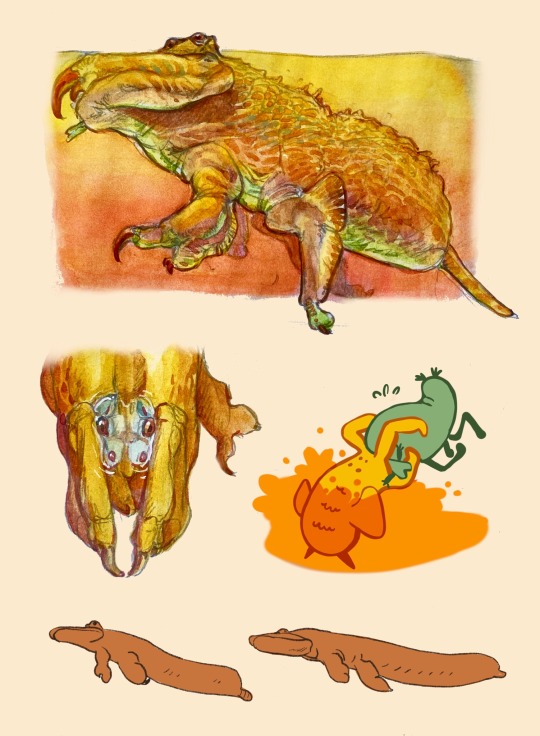
This is far from my first attempt at designing an amphibious ambush predator, but I think this is the first iteration I’m really satisfied with. Known to the twowi as Saugu-gui, this is a family of heavily built animals that seize prey near the surface of rivers and lakes with their long forelimbs and use their own bulk and muscular appendages to drag it underwater. The actual chelicerae are small and used only for food processing after prey has been successfully dispatched. The species most readily known to the twowi is the stocky variety sketched at top, large and strong enough to prey on sheep sized organisms, through much longer bodied species are found elsewhere in the world.
They are cumbersome on land but the short bodied Saugu-gui can travel surprisingly long distances overland when searching for a mate and a suitable nursery site. Carrier larvae are fully aquatic, settling in the mud after “laying” to live as filter feeders for several years. Each one produces a few dozen tiny, predatory true larvae at the end of its lifespan, which retain the primitive ability to breathe underwater for the first few months of life.
———
Put this one up for free on my patreon this week, where ive got a bunch of other miscellaneous worldbuilding for those interested
452 notes
·
View notes
Text
I dig the composition! Where ARE they going…

Another @iguanodont 's birgworld fanart.
A Birg climbing a mountain while a Cliffstriker watches... Where are they going...
A simple gouache practice this time with new techniques such as layering an underpaint before painting. Still need to tame this new brush...
136 notes
·
View notes
Note
Do you do both traditional and digital? Because your art looks like a mix of both and its really interesting
I do! Most of my art is a composite of both to some degree, though the flag chase piece was almost entirely watercolor/acrylic with some generous color enhancing in procreate.
53 notes
·
View notes
Text



Just wanted to share the birg patch I embroidered on my hoodie! I feel like the fully completed photo dosent do it justice because some of the threads have swayed a bit since it’s been washed
476 notes
·
View notes
Text

The Flag Chase
Shown here is a late summer ritual carried out by the Ruruumi bachelor group: garbed in little more than a decorative collar, a young gifter climbs onto the back of a wild Ahoũitre, the Resplendent Flagdeer, to remove its brilliantly colored display feathers as a trophy to present during the nuptial gifting ceremonies in the fall. Using an obsidian knife, the cut must be clean enough to shed no more than a few drops of blood, without damaging the feathers, and performed without being hurled to the ground by the bucking animal. It is a sport requiring an impressive display of courage, agility, and control over one’s own trunkhorse, and for many kakroum bachelors, this and related high risk sports are a rite of status in their tightly knit brotherhoods. Many bachelor groups will specialize in ‘capturing’ a specific animal, though flagdeer are exceptionally prized for their feathers, which adorn the regalia of many clan residents. It is a feat that frequently ends in serious injury or death, but something that only a frivolous gifter can afford to perform, free from the responsibility of maintaining a village. In the process, he proves in himself the sort of strength and cleverness that any would-be mother would wish to see in her own daughters.
As for the flagdeer, it will be released after having been separated from its feathers. Though its wounds are relatively minor, it will have no hope of impressing its own kind in the coming mating season. Flag removal is a strategy employed by sparring male flagdeer as well, which will attempt to mangle or nip off the other’s display feathers to oust the competition. If the damage is minor, the flags will regrow the following year, but the cut made a birg’s knife frequently takes the entire “hand” of the appendage, preventing a complete regeneration.
Milder imitations of this sport are practiced by both children and adults. One common variant involves two teams, each defending am urwuzhu (mid-sized livestock) with a ribbon or flag tied to some part of its body. The opposing teams attempt to remove the flag from each other’s animal and carry it back to their section of the village. Such games can become immensely rowdy and still result in a lot of bruises, scrapes, and animal bites. Twowi children play a similar game, but wanting for a farm animal will chase after a fellow birg’s tail tassels instead.
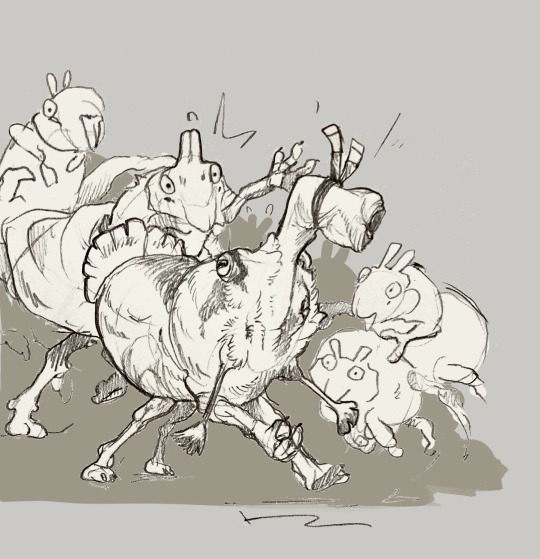
————
If you want to more creatures and worldbuilding notes, consider checking out my Patreon
I also have a Tip Jar
Or if you want this piece on your wall, you can buy a print
821 notes
·
View notes
Note
I absolutely love the swimslugs. They are so completely different from the birgs and yet fit your style so well. Might I ask, how big/small are these wonderful sluggy dudes?
I’m glad you like em! Compared to humans, birgs, and millipeebs, swimslugs are little guys. Just larger than a football.
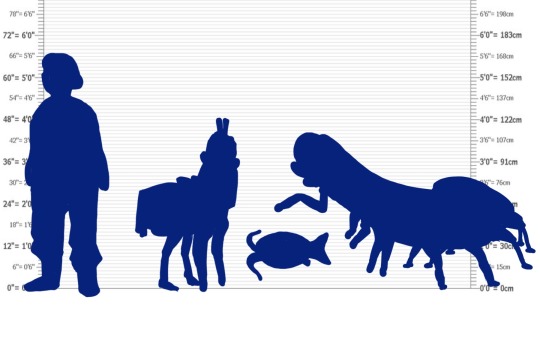
174 notes
·
View notes
Note
So what are sophonts? I've heard another artist use that word and I thought it referred to his own invented species.
It’s just a term to refer to a species with high intelligence. I.e. able to form languages, cultures, build complex tools similar to humans.
120 notes
·
View notes
Note
How adept at throwing birgs are?
Pretty abysmal. Their shoulders aren’t built for it and they struggle to gauge distance at close ranges.
76 notes
·
View notes
Text
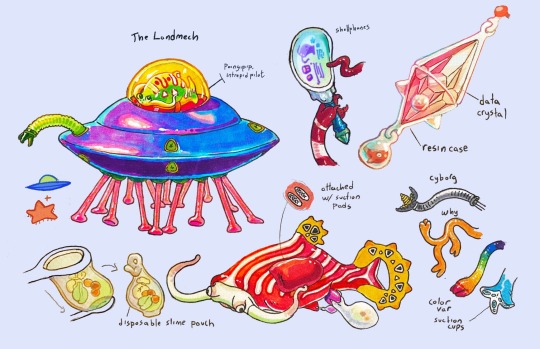
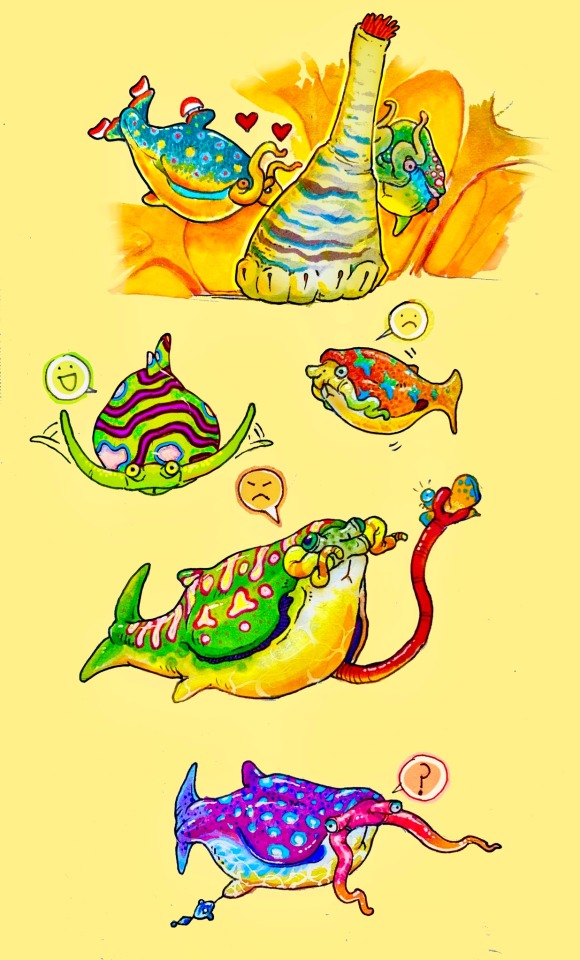

Emerges from my cave to announce I have created a new sophont
Tentatively calling swimslugs for now, as their designs mostly draw from mollusc anatomy. These small, colorful creatures dwell on a high gravity world dominated by shallow golden seas. Electrical engineering came early in their history, inspired by the ability of some of their native animals to generate electrical currents… and their own natural electroreception. The last few centuries have been peaceful and prosperous; their myriad cultures emphasize an exchange of art, culture, and friendly competition to sport the tackiest color schemes imaginable. Due to the high gravity of their world and their own physical limitations as aquatic creatures, swimslugs have a very limited history of aviation and have been generally uninterested in space travel, despite having been digital penpals with another group of sophonts for generations now…
On their biology:
Swimslug life relies on symbioses with two different organisms: a worm and a sessile “tunicate”. The worm (also simply referred to as an ‘arm’) is functionally a parasite; biting into the flank under the gills of its host early in life and fusing with its nervous and circulatory systems. This union allows the swimslug to develop fine motor control over the untethered end of the worm by adolescence. Most swimslugs only host a single arm; two or more become difficult for most individuals to acclimate to and can lead to health issues. Many genetic and cybernetic variations of the arm are available in the current era. The ‘tunicate’ (I will refer to as the Vase) is essential to swimslug reproduction; all parents spawn into the Vase to ensure a safe shelter and a steady current of oxygenated water for the developing offspring. The average swimslug has at least two fathers; the hybridization of multiple sets of gametes is essential to the proper development of their species. Family groups often consist of the egg layer, her family Vase (these can last for generations), and a 3 or 4 mates, though the particulars vary enormously by culture. Their eggs have a relatively low hatch rate; unviable eggs are consumed by surviving larvae shortly after hatching. The Vases themselves periodically produce free swimming larvae that are affectionately kept around dwellings as pets.
Swimslugs communicate by grinding and clacking modified stomach-teeth, as well as percussing on the adjacent ‘oil-sac’ organ that also serves to regulate buoyancy and store energy. They come in a dazzling variety of colors owing to both their complex hybridizations and genetic engineering. Cosmetic nanobots applied to their slime coats enhance their appearance by functioning as artificial chromatophores.
And that’s the gist of em! Many thanks to @nknatteringly for all the idea pitching and bouncing in their early development, wouldn’t have felt half as inspired without ya. Not sure how much further I’ll develop these guys, they exist mostly as a fun diversion to contrast the gritty, low-tech world of the birgs and a love letter to all the sparkly stuff I liked as a kid.
If you’d like to support my art, you check out these links here
———
Patreon
Kofi
Inprnt
1K notes
·
View notes
Text
These are so perfect and wonderful I’m over the moon
In return. I grant you splatoon guys :D

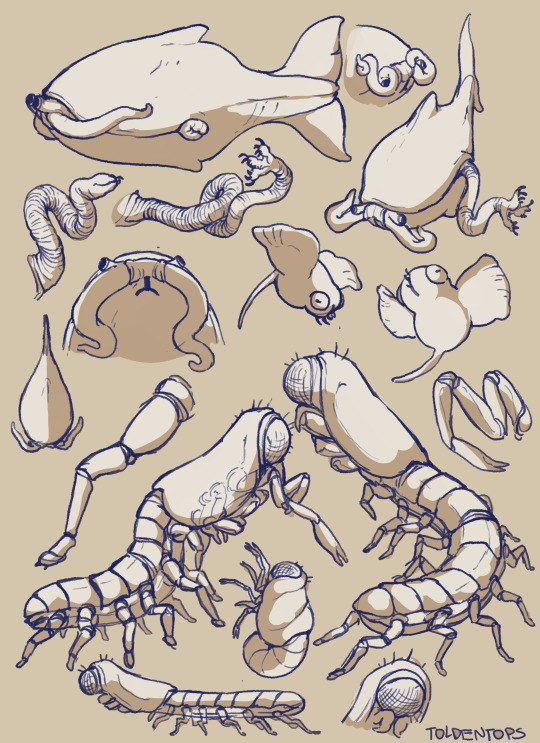
Art trade for @iguanodont featuring a collection of their beasts!
#friend art#not my art#I need to make a real post about these new aliens but this is how they’re getting revealed I guess lol
515 notes
·
View notes
Note
Your art is a delight and really makes me think more (and a lot deeper) about spec bio and cultures themselves. You really make my days better, so thank you!! Have a wonderful day
And now this kind message has made my day ❤️Thank you, kind anon! It’s going to be a long day at work but I will do my best!
85 notes
·
View notes
Text
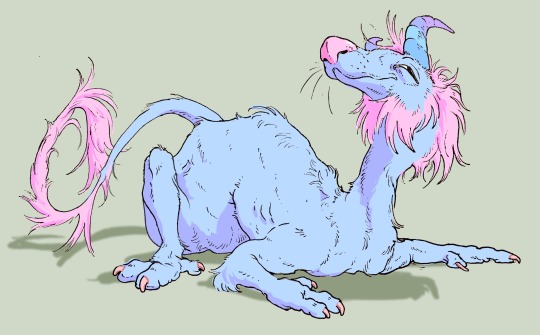
And here’s what I drew in return! @jue-jack ‘s character Genesis Beast.

my part of an art trade with @iguanodont 's original species, a gold dragon 🐲🐉
512 notes
·
View notes
Text
for options 2 through 5 please elaborate in comments if you have any specific suggestions in that category!
81 notes
·
View notes
Text
Mentioned briefly in my last post, but I do in fact have holographic worm stickers for sale now.

There’s far more to the world of Annelida than the humble nightcrawlers you find in your yard; many species are found in marine environments, where they take such varied forms as the fearsome bobbit worm or the ethereal tomopteris. Here I’ve rendered a ragworm (family Nerididae); a sort of polychaete (bristle worm) found in benthic marine (and occasionally freshwater) environments the world over.
Some cool facts to win you over:
1. The largest ragworm in the world is the king ragworm (Alitta virens), which ready achieves lengths of 4 ft/120 cm.
2. Ragworms are an important part of the live sea-bait industry. Unfortunately that also means they have been harvested so extensively in some areas that their populations are threatened.
3. Ragworms reproduce through a bizarre process called epitoky, in which the benthic worm either transforms into a free-swimming reproductive morph, or buds off several free swimming sex-clones to party in the world above. Either way, it will be the final act of the animal’s life.
4. Ragworms, like bobbit worms, have large, eversible mandibles in their pharynx that they extrude to give a nasty bite.
5. On the topic of ragworm jaws, the material they are made of is very strong and lightweight, despite lacking the calcium mineralization of most other animals with hard body structures. There is some research investigating its structure for aerospace engineering applications!
533 notes
·
View notes